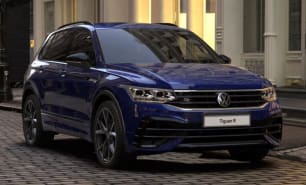The XC60 Recharge is an interesting car to drive. The first thing you’ll notice is how quiet it is. The sound deadening is impressive, as is the smooth and silent electric drive, and even the engine, unless pushed hard, is quiet enough that it’s hard to tell when the car switches between its two power sources.
The steering offers a pleasant balance of electrical assistance and mechanical feedback, suited to the character of the car, and the ride is similarly forgiving despite the large alloy wheels.
This is a hybrid which hides the additional weight of its batteries well, again courtesy of the air suspension, which actively balances out the sway of the additional heft, and filters out what could otherwise be a crashy ride.
To give you an idea of the way this car feels, it’s nowhere near as sharp or sporty as the BMW X3 xDrive 30e, but feels better balanced, less cumbersome, and rides better than the Mercedes GLC 300e or Lexus NX 450h+.
The software is very clever, not only seamlessly blending the combustion front axle with the electrified rear, but also having the digital dash showing you the cut-off points for both the engine turning on and where the mechanical brakes will take over from the regenerative braking.
On this topic, the XC60 doesn’t have single-pedal regenerative braking, at least not in the default hybrid driving mode, relying instead on a fully blended system. This means it will blend the regenerative properties in with the mechanical properties depending on how hard the brake pedal is pressed.
While this is a clever piece of software trickery, like seemingly everything in the XC60 Recharge, it seems to be designed to make the drive experience similar to combustion versions. This makes it approachable, but to extract the ideal level of efficiency from the electric features, you’ll need to factor in the ideal stopping distance from traffic.
With the battery charged it’s lovely as an electric car, but the combustion engine is a strong performer, too, with the two combining to make for a very fast SUV in a straight line.
Finally, in terms of altering the drive experience, the XC60 Recharge offers fully electric, hybrid, and fully combustion driving modes, with settings to offer control over the charge level. Want to drive it as a Toyota-style hybrid? You can; just put it in hybrid mode and ask it to maintain battery level. Want to run only combustion to save your charge for when you exit the freeway and are driving around town? You can do that, too. You can even ask the car to use the combustion engine to charge the battery. Not the most environmentally conscious feature, but one not all PHEVs offer.
There’s a lot to like then, it’s quick but not too sharp, focusing instead largely on being comfortable, familiar, and quiet, suiting the family-friendly appeal of the Volvo brand.

